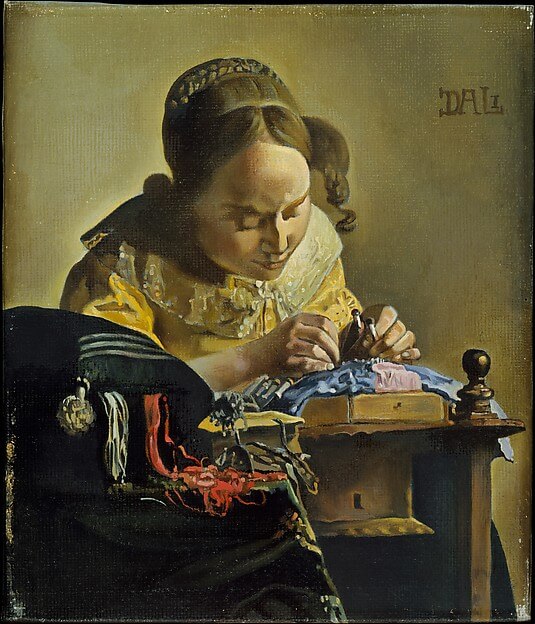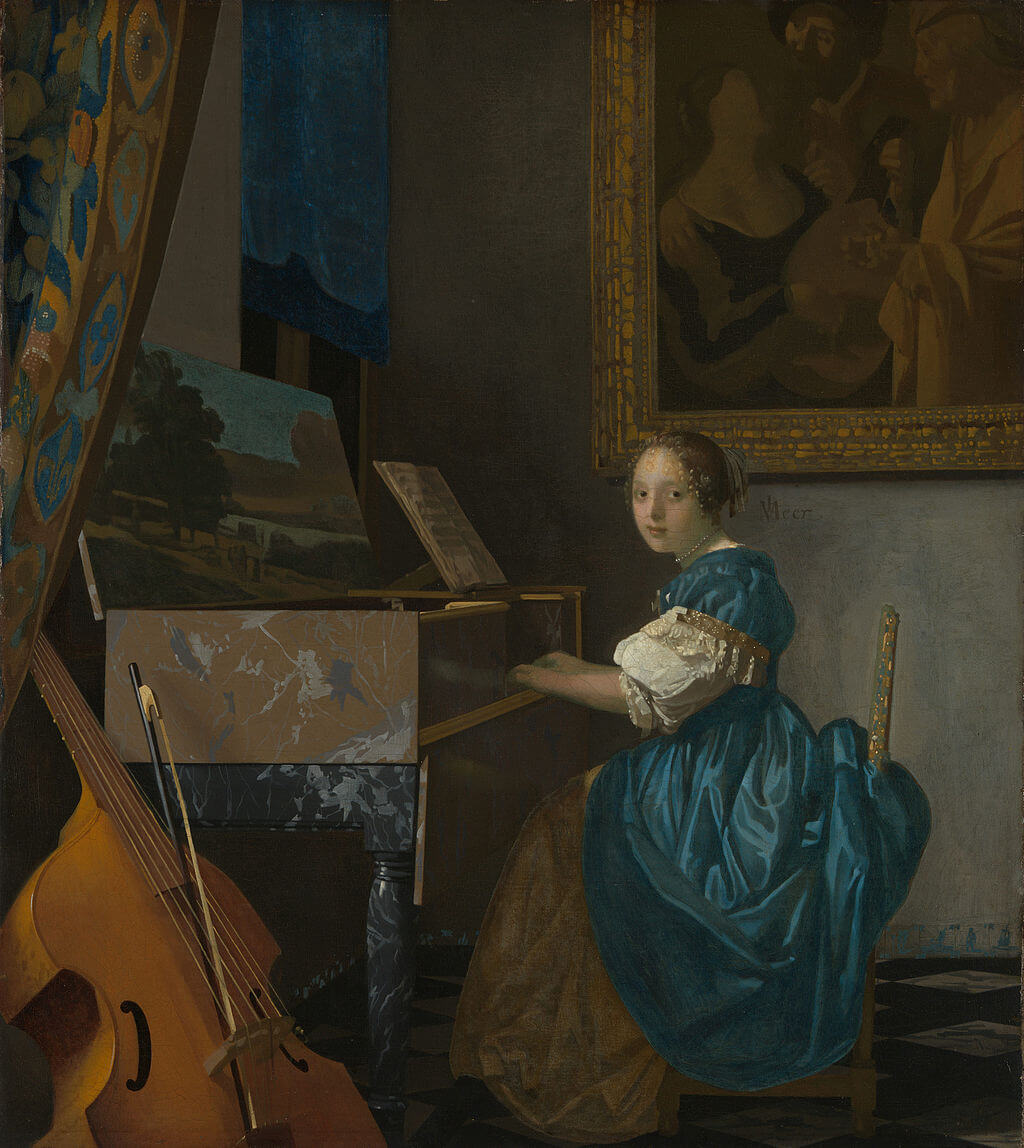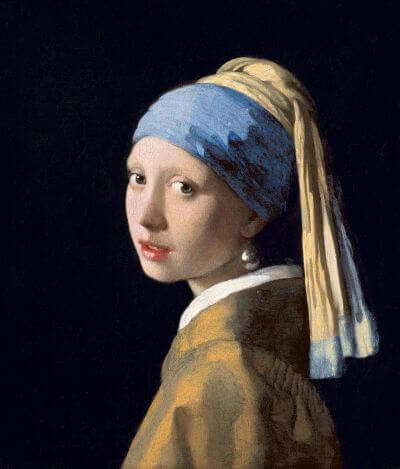|
Where? Second floor, room 837 of the Richelieu wing in the Louvre
When? 1669-1670 What do you see? A young woman is leaning forward and is making lace on a blue pillow. She concentrates on her work and holds two pins and two small cylinders with threads around them. She uses a lacemaking technique in which the threads on the cylinders are unrolled onto the pillow. The threads are tied into knots, each stitch is pinned temporarily, and the pins move forward as new knots are made. The woman wears a yellow dress with a white lace collar. Her hair has a couple of splits, with a braid on top, and, so-called, lovelock on her left (our right). A blue tablecloth with a large flower pattern is on top of the table. You can identify large green leaves and the yellow and red paint is part of the flowers. On top of the table is a blue pillow, which serves as a workbox for making lace. White and red threads, probably from silk, come out of the cushion on the bottom left. To the right of the pillow is a yellowish book, which is probably a Bible. Backstory: The Louvre bought this painting in 1870 for 1,254 French francs (which is equivalent to $254 at that time). It is the smallest among all paintings by Vermeer. The painting seems out of focus (even a bit abstract at places), something that Vermeer did on purpose to draw us closer to the painting to observe its details. Combined with its small size, this is indeed what many people do when looking at the painting. Salvador Dalí has made a copy of The Lacemaker which is owned by the Metropolitan Museum of Art. The Lacemaker by Vermeer is painted on a canvas with coarse fiber of 12 x 12 threads per square centimeter. Vermeer used the weave of the canvas as the wall in the background of this painting. The canvas for The Lacemaker is identical to the one Vermeer used for his Lady Seated at a Virginal in the National Gallery in London. In fact, the similarity in the canvas has helped to identify that painting as being made by Vermeer.
Who is Vermeer? Johannes Vermeer (1632-1675) was born in Leiden, The Netherlands. He was a very precise and slow-working artist, which led to paintings with great attention to detail, especially with regards to light effects, and great compositions. The light effects can also be found in this painting. Look, for example, at the sleeve on her right arm where he used simple shadows to paint the folds.
Vermeer used expensive pigments for his paintings, but only used a limited number of colors (only a total of 20 pigments have been identified across his paintings). He is well-known for using the very expensive ultramarine color in his paintings, including in this painting. Some of his most famous works include his Girl with a Pearl Earring in the Mauritshuis in The Hague and The Milkmaid in the Rijksmuseum in Amsterdam.
Fun fact: Until the 19th century, lace was very expensive and was a great way to signify wealth and fashion. Its status was comparable to owning tapestries and jewelry. Lace was often depicted in white and painters used the whitest paint to include lace in their paintings. Making lace was not easy and was often a profession which required long working hours. Alternatively, it was a way for housewives to make some extra money.
There were even quite some schools for lacemakers where two different techniques were taught. One technique was to make lace using the cylinders (called bobbins) as seen in this painting. Another technique was called needle lace where lace was created using a needle to sew the lace. The courts in many countries included lace elements in the attire of the judges, and this practice has been ongoing for centuries, though many countries have now modernized the attire of the judges. Interested in a copy for yourself? Poster
Written by Eelco Kappe
References:
2 Comments
7/27/2019 01:37:48 am
I will become editor of the Australian Lace Guild's Journal (a not for profit membership of lacemakers who make bobbin lace in Australia) later this year and would like to be able to use the image and story of The Lacemaker by Johannes Vermeer in this publication. How do I gain permission and an image I could use?
Reply
Dr Cyril Watson
11/2/2021 05:52:22 pm
Love what the experts say about Vermeer, his paintings and subjects. (Ref. Sky Arts Vermeer: from the National Gallery}. Want to study more about Vermeer and his works now.
Reply
Leave a Reply. |
Categories
All
|
- Home
- Blog
-
Museums
- Alte Pinakothek
- Art Institute of Chicago
- Baltimore Museum of Art
- Barber Institute of Fine Arts
- Bargello
- Barnes Foundation
- British Museum
- Church of Sant’Anastasia
- Cleveland Museum of Art
- Courtauld Institute of Art
- Detroit Institute of Arts
- Frans Hals Museum
- Galleria Borghese
- Gallerie dell'Accademia
- Getty Museum
- Guggenheim
- Hermitage Museum
- Kunsthistorisches Museum
- Kunstmuseum Basel
- Legion of Honor Museum
- Louvre
- Mauritshuis
- Metropolitan Museum of Art
- Musee d’Orsay
- Museum of Fine Arts in Boston
- Museum of Modern Art
- National Gallery in London
- National Gallery of Art
- National Museum in Poznań
- Norton Simon Museum
- Ny Carlsberg Glyptotek
- Palace of Versailles
- Palazzo Pitti
- Palazzo Vecchio
- Petit Palais
- Philadelphia Museum of Art
- Prado
- Pushkin Museum
- Ravenna Art Museum
- Rijksmuseum
- San Diego Museum of Art
- Santa Maria delle Grazie
- St. Peter's Basilica
- Städel Museum
- Statens Museum for Kunst
- Tate Britain
- Tate Modern
- Timken Museum of Art
- Uffizi
- Vatican Museums
- Wallace Collection
-
Artists
- Altdorfer
- Anguissola
- Berlin Painter
- Bosch
- Botticelli
- Boucher
- Bronzino
- Bruegel the Elder
- Brunelleschi
- Cabanel
- Caillebotte
- Canova
- Caravaggio
- Carpeaux
- Cezanne
- Cimabue
- David
- Degas
- Delacroix
- De Maria
- Donatello
- El Greco
- Fontana
- Fra Angelico
- Fragonard
- Gauguin
- Gentileschi
- Gericault
- Gonzalez-Torres
- Goya
- Hals
- Hogarth
- Hokusai
- Ingres
- Leonardo da Vinci
- Lippi, Filippo
- Longhi, Barbara
- Lorrain
- Makovsky
- Manet
- Massys
- Matisse
- Merian
- Michelangelo
- Mochi
- Modigliani
- Monet
- Panini
- Parmigianino
- Perugino
- Picasso
- Pisanello
- Raphael
- Rembrandt
- Renoir
- Reynolds
- Rivera
- Rodin
- Rubens
- Scultori
- Seurat
- Steen
- Tintoretto
- Titian
- Toulouse-Lautrec
- Turner
- Uccello
- Van der Weyden
- Van Dyck
- Van Eyck
- Van Gogh
- Van Hemessen
- Vasari
- Velazquez
- Vermeer
- Veronese
- Vigée Le Brun
-
Locations
- Books
- About Us





